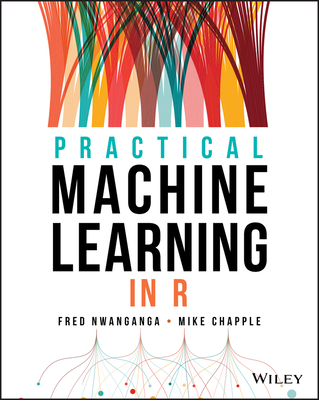Machine Learning with Python Cookbook: Practical Solutions from Preprocessing to Deep Learning
暫譯: Python 機器學習食譜:從預處理到深度學習的實用解決方案
Chris Albon
- 出版商: O'Reilly
- 出版日期: 2018-05-01
- 定價: $2,300
- 售價: 9.0 折 $2,070
- 語言: 英文
- 頁數: 366
- 裝訂: Paperback
- ISBN: 1491989386
- ISBN-13: 9781491989388
-
相關分類:
Machine Learning、Python
-
相關翻譯:
Python 機器學習錦囊妙計 (Machine Learning with Python Cookbook) (繁中版)
Python 機器學習手冊:從數據預處理到深度學習 (Machine Learning with Python Cookbook: Practical Solutions from Preprocessing to Deep Learning) (簡中版)
-
其他版本:
Machine Learning with Python Cookbook: Practical Solutions from Preprocessing to Deep Learning 2nd Edition
買這商品的人也買了...
-
 基礎通信理論 (Basic Communication Theory)
基礎通信理論 (Basic Communication Theory)$350$333 -
 深入淺出 Python (Head First Python)
深入淺出 Python (Head First Python)$780$616 -
 Python for Finance (Paperback)
Python for Finance (Paperback)$1,650$1,568 -
 Bioinformatics Data Skills: Reproducible and Robust Research with Open Source Tools (Paperback)
Bioinformatics Data Skills: Reproducible and Robust Research with Open Source Tools (Paperback)$1,853$1,755 -
 精通 Python|運用簡單的套件進行現代運算 (Introducing Python: Modern Computing in Simple Packages)
精通 Python|運用簡單的套件進行現代運算 (Introducing Python: Modern Computing in Simple Packages)$780$616 -
 Fundamentals of Engineering Electromagnetics (An Adapted Version)
Fundamentals of Engineering Electromagnetics (An Adapted Version)$1,150$1,127 -
 Introduction to Machine Learning with Python: A Guide for Data Scientists (Paperback)
Introduction to Machine Learning with Python: A Guide for Data Scientists (Paperback)$2,071$1,962 -
 PHP 學習手冊 (Learning PHP: A Pain-Free Introduction to Building Interactive Websites)
PHP 學習手冊 (Learning PHP: A Pain-Free Introduction to Building Interactive Websites)$580$458 -
 Practical Statistics for Data Scientists: 50 Essential Concepts
Practical Statistics for Data Scientists: 50 Essential Concepts$1,800$1,710 -
 $990Hands-On Machine Learning with Scikit-Learn and TensorFlow (Paperback)
$990Hands-On Machine Learning with Scikit-Learn and TensorFlow (Paperback) -
 $1,888Feature Engineering for Machine Learning: Principles and Techniques for Data Scientists
$1,888Feature Engineering for Machine Learning: Principles and Techniques for Data Scientists -
 $888Python Data Structures and Algorithms
$888Python Data Structures and Algorithms -
 $1,260Python GUI Programming Cookbook - Second Edition
$1,260Python GUI Programming Cookbook - Second Edition -
 $301Python 機器學習經典實例 (Python Machine Learning Cookbook)
$301Python 機器學習經典實例 (Python Machine Learning Cookbook) -
 $1,248Pandas for Everyone: Python Data Analysis (Addison-Wesley Data & Analytics Series)
$1,248Pandas for Everyone: Python Data Analysis (Addison-Wesley Data & Analytics Series) -
 資訊架構學, 4/e (Information Architecture: For the Web and Beyond, 4/e)
資訊架構學, 4/e (Information Architecture: For the Web and Beyond, 4/e)$680$537 -
 Python 深度學習 (Python Deep Learning)
Python 深度學習 (Python Deep Learning)$620$484 -
 AI 及機器學習的經脈:演算法新解
AI 及機器學習的經脈:演算法新解$690$587 -
 Python 網頁程式交易 APP 實作:Web + MySQL + Django
Python 網頁程式交易 APP 實作:Web + MySQL + Django$680$530 -
 Deep Learning with PyTorch: A practical approach to building neural network models using PyTorch
Deep Learning with PyTorch: A practical approach to building neural network models using PyTorch$1,650$1,568 -
 Flask 網頁開發, 2/e (Flask Web Development : Developing Web Applications with Python, 2/e)
Flask 網頁開發, 2/e (Flask Web Development : Developing Web Applications with Python, 2/e)$580$458 -
 Python 機器學習, 2/e (Python Machine Learning, 2/e)
Python 機器學習, 2/e (Python Machine Learning, 2/e)$690$538 -
 $2,340Linear Algebra and Optimization for Machine Learning: A Textbook (Hardcover)
$2,340Linear Algebra and Optimization for Machine Learning: A Textbook (Hardcover) -
 Elementary Linear Algebra, 12/e (AE-Paperback)
Elementary Linear Algebra, 12/e (AE-Paperback)$1,580$1,548 -
 (人人伽利略 18) 超弦理論:與支配宇宙萬物的數學式
(人人伽利略 18) 超弦理論:與支配宇宙萬物的數學式$400$340
相關主題
商品描述
This practical guide provides nearly 200 self-contained recipes to help you solve machine learning challenges you may encounter in your daily work. If you’re comfortable with Python and its libraries, including pandas and scikit-learn, you’ll be able to address specific problems such as loading data, handling text or numerical data, model selection, and dimensionality reduction and many other topics.
Each recipe includes code that you can copy and paste into a toy dataset to ensure that it actually works. From there, you can insert, combine, or adapt the code to help construct your application. Recipes also include a discussion that explains the solution and provides meaningful context. This cookbook takes you beyond theory and concepts by providing the nuts and bolts you need to construct working machine learning applications.
You’ll find recipes for:
- Vectors, matrices, and arrays
- Handling numerical and categorical data, text, images, and dates and times
- Dimensionality reduction using feature extraction or feature selection
- Model evaluation and selection
- Linear and logical regression, trees and forests, and k-nearest neighbors
- Support vector machines (SVM), naïve Bayes, clustering, and neural networks
- Saving and loading trained models
商品描述(中文翻譯)
這本實用指南提供了近200個獨立的範例,幫助您解決在日常工作中可能遇到的機器學習挑戰。如果您對Python及其庫(包括pandas和scikit-learn)感到熟悉,您將能夠解決特定問題,例如加載數據、處理文本或數值數據、模型選擇、降維以及許多其他主題。
每個範例都包含可以複製並粘貼到玩具數據集中的代碼,以確保其實際可用。從那裡,您可以插入、組合或調整代碼,以幫助構建您的應用程序。範例還包括解釋解決方案的討論,並提供有意義的背景。這本食譜書讓您超越理論和概念,提供構建可運行機器學習應用所需的基本知識。
您將找到以下範例:
- 向量、矩陣和數組
- 處理數值和類別數據、文本、圖像以及日期和時間
- 使用特徵提取或特徵選擇進行降維
- 模型評估和選擇
- 線性和邏輯回歸、樹和森林、以及k最近鄰
- 支持向量機(SVM)、朴素貝葉斯、聚類和神經網絡
- 保存和加載訓練好的模型











